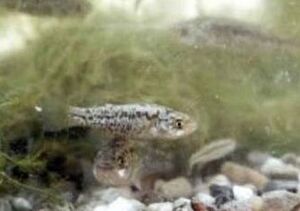Empetrichthys latos facts for kids
Quick facts for kids Empetrichthys latos |
|
|---|---|
 |
|
| Conservation status | |
| Scientific classification |
The Empetrichthys latos, also known as the Pahrump poolfish, is a very rare type of fish. It belongs to a family of fish called Goodeidae, which are often called splitfins. This special fish lives only in Nevada, a state in the United States. It used to live in the Pahrump Valley, but its home was destroyed. Because of this, the Pahrump poolfish almost disappeared completely.
Today, the Pahrump poolfish is listed as an endangered species by the United States government. Even though it's a small fish, it can live for a long time. Female poolfish can live up to 10 years, and males can live up to 7 years!
Contents
About the Pahrump Poolfish
The Pahrump poolfish looks a bit different depending on if it's a male or a female. Females are usually much bigger than males. This difference is important for scientists who are trying to help the fish survive.
What Does It Look Like?
This fish can grow to be about 7 centimeters (or 2.8 inches) long. Its back fins and belly fins are located far back on its body. It doesn't have the fins that most fish have on their bellies, which are called pelvic fins. The front part of its head is a bit flat, and it has a wide mouth. Its lower jaw sticks out further than its upper jaw.
The Pahrump poolfish is usually greenish on its back and a shiny silvery-green on its belly. When it's time for the male fish to lay eggs (a process called spawning), his body can turn a pretty blue color.
What Does It Eat?
The Pahrump poolfish is an omnivore, which means it eats both plants and animals. It enjoys a variety of food found in its watery home.
Life Cycle and Habitat
These fish usually lay their eggs in the spring, but they can reproduce at any time of the year if the conditions are just right. Adult poolfish are more active at night, while the younger fish seem to be more active during the day.
The Pahrump poolfish naturally lived in pools and marshes. The water in one of its original homes, Manse Spring, was always around 24 degrees Celsius (75 degrees Fahrenheit). This might be the best temperature for them, but they can handle a wide range of temperatures. They have even been seen surviving under a layer of ice in winter! The water where they live is also alkaline, which means it's not acidic.
History of the Pahrump Poolfish
The Pahrump poolfish is the only type of fish left in its group, called Empetrichthys. Another fish from this group, the Ash Meadows killifish, sadly died out in the 1940s.
There used to be three different kinds (or subspecies) of the Pahrump poolfish. Each one lived in a different spring in the Pahrump Valley. Sadly, two of these subspecies are now extinct.
Lost Subspecies
- The Raycraft Ranch springfish (E. latos concavus) disappeared when its spring was destroyed in the 1950s.
- The Pahrump Ranch killifish (E. latos pahrump) vanished when its spring was pumped dry in 1958.
The only one left is the Pahrump poolfish we know today, E. latos latos.
Efforts to Save the Poolfish
In 1975, the Pahrump poolfish disappeared from its last natural home, Manse Spring. This happened because of several problems:
- New fish like goldfish were brought in and competed for food and space.
- Some plants were removed from the spring.
- The spring itself started to dry up because too much groundwater was being pumped out nearby.
When scientists realized the fish were in danger, they quickly moved some of them to three new pools in different parts of Nevada. In 1980, the United States Fish and Wildlife Service (USFWS) created a plan to protect and manage these new groups of fish. The Pahrump poolfish has not been returned to Manse Spring because the area is being developed, and there isn't enough reliable water.
Challenges in New Homes
Even in their new homes, the Pahrump poolfish faced many challenges:
- One pool was destroyed by flooding.
- Some fish were killed by vandalism at another pool.
- Other fish, like mosquitofish and crawfish, were accidentally or illegally introduced, which threatened the poolfish.
Some fish were moved to a reservoir after the flood. The USFWS even had to step in when officials planned to dredge (clean out) the pond where the fish lived.
Today, these groups of Pahrump poolfish still exist, but their homes sometimes need special care to keep them going. As of 2004, only one group of fish was considered stable. Threats like groundwater pumping, vandalism, and new species still put the fish at risk. In 2018, the Southern Nevada Water Authority planned to create another safe home for the fish at the Las Vegas Springs Preserve. The USFWS still believes the Pahrump poolfish is "in imminent danger of extinction" and continues to list it as an endangered species.
Images for kids




